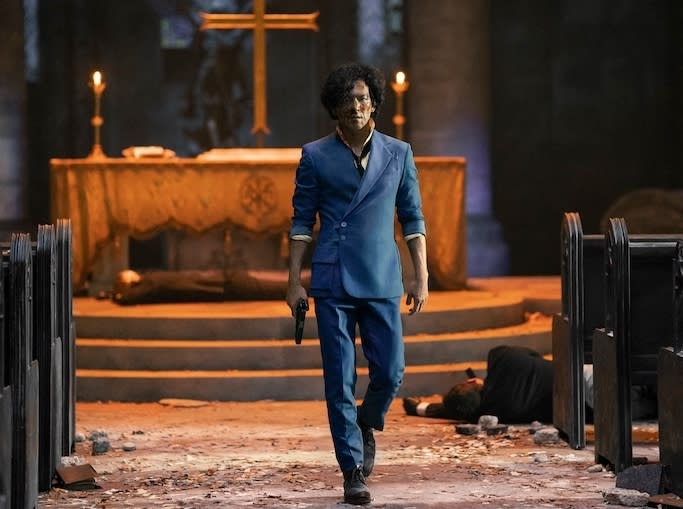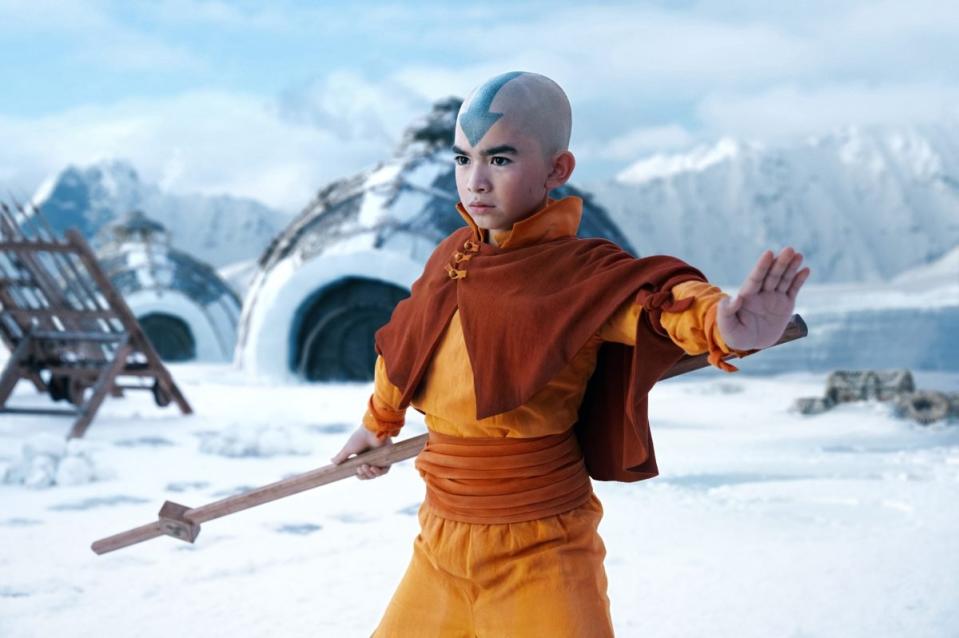The Pitfalls of Netflix’s Live-Action Anime

- Oops!Something went wrong.Please try again later.
- Oops!Something went wrong.Please try again later.
The first episode of Netflix’s “One Piece,” an English live-action adaptation of the long-running Japanese manga series from artist Eiichiro Oda, starts off the same way that the first 47 installments of said manga’s anime adaptation begins. The franchise is set in an unnamed world covered almost completely by sea, where piracy runs rampant thanks in part to the execution of the King of the Pirates, Gold Roger. Before his death, Roger told onlookers that his life’s treasure, the so-called “One Piece,” was hidden away somewhere, and whoever found it would be his worthy successor.
In the anime version of this moment, Roger’s final moment is handled via a roughly 20-second intro to the show’s credits sequence, portrayed as a series of finely-detailed drawings on a long piece of parchment paper. The Netflix series, which releases all eight of its episodes on Thursday, opts to fully dramatize the execution: Roger is played (inexplicably) by Michael Dorman of “For All Mankind” fame, caked in makeup and a fake mustache meant to resemble Oda’s original character design. The scene begins by swooping through a bay filled with CGI ships, before settling on a town square filled with a CGI audience to the execution. After some onlookers pester him for his treasure’s location, Roger gives his speech about the One Piece, and he’s stabbed to death about three and a half minutes into the episode. Essentially, it’s the same thing fans of the anime are familiar with — except longer, uglier, and not as fun.
More from IndieWire
Emerald Fennell Had Never Seen 'Euphoria' Before Casting Jacob Elordi in 'Saltburn'
Lily Gladstone Calls 'Yellowstone' a 'Delusional' Portrayal of the American West
Taking an animated property into live-action is nothing new. Disney first did it in the ’90s, when their classic ’60s films “The Jungle Book” and “101 Dalmatians” were turned into big-budget, starry family films featuring the likes of Glenn Close. But in the modern age of streaming, where companies aggressively adapt IP and brands to fill glutted content libraries, animation sometimes feels like it’s being treated less as a completely separate independent medium and more as source material for inevitable live-action series.
Since roughly 2015’s “Cinderella,” Disney has ramped up the release of live-action remakes for their iconic animated movies considerably, burning through so many of their well-known classics like “The Little Mermaid” that they’re now producing a live-action version of “Moana,” a film that’s barely seven years old. Earlier this month, the company debuted the new “Star Wars” streaming series “Ahsoka.” Ostensibly, it’s a spinoff of “The Mandalorian,” but in practice it functions as a sequel to animated series “The Clone Wars” and “Rebels,” which introduced the title character and the majority of its ensemble, all now portrayed by different actors (Lars Mikkelsen, who played menacingly sexy blue baddie Thrawn in “Rebels,” is the sole voice actor to survive the jump to live-action). The costumes and prosthetics makeup are carefully crafted to mold actors like Rosario Dawson and Mary Elizabeth Winstead in the image of the CGI cartoons, which is presumably meant to be fan service. It has a far more depressing effect, sending the odd message that the animated renditions of these characters, so lively and vibrant, were mere test runs for the “real” versions seen in the show.
Netflix, as a relative newbie to the content game, doesn’t have the legacy of cartoons to plunder for remakes; they have to outsource their cash grabs. Increasingly, their strategy has focused on beloved anime and manga properties and repurposing them as live-action for audiences who presumably aren’t familiar with the original. In 2017, the streamer released “Death Note,” an almost instantly forgotten teen film that sanded off the dark edges of the popular manga series from which it was adapted. In 2021, there was “Cowboy Bebop,” a live-action remake of arguably the most acclaimed anime of all time, at least in the United States. The show, led by a strong John Cho, received savage reviews from critics and fans alike, and was canned by the streamer a mere month after its premiere.
Despite those failures, the company apparently remains convinced that live-action anime adaptations have an audience on the platform. In addition to “One Piece,” next year will bring us a (second, after the maligned M. Night Shyamalan movie) remake of “Avatar: the Last Airbender” — an American series that aired on Nickelodeon, but one that is heavily indebted to and styled after Japanese animation.

“One Piece” isn’t quite the disaster on par with “Cowboy Bebop,” in part because it makes a concentrated effort to embrace its animated roots. Oda’s series is, maybe more than “Cowboy Bebop,” too big to disrespect: running consistently since 1997, the manga is the best-selling comic book of all time, with over 516.5 million volumes sold worldwide. It’s also a series that very much thrives on the fact that it’s a cartoon, with wacky character designs and powers, like main hero Luffy’s ability to use his body like rubber, that often make it resemble “Looney Tunes” more than an action series.
The live-action series tries, to the best of its ability, to put the world of the manga in a real-life environment. The ships are faithfully outlandish; early villain Alvida (Ilia Isorelýs Paulino) commands a pink vessel with red hearts on its sails, while Luffy and his crew of Straw Hat pirates eventually acquire the Going Merry, a ship with a braying sheep carved out of marble for a figurehead. Actors wear costumes accurate to the original manga, with colorful hairstyles to match; minor character Merry still inexplicably has ram horns sticking out of his head. In one fun visual touch, several of the villainous pirates are introduced by their wanted posters fluttering briefly onto screen.
The problem, however, is that the show is unable to pull the mountains of CGI and bad hairstyling together into something resembling a coherent artistic style. Anime-inspired films that made the jump between mediums smoothly include the 2008 “Speed Racer” film, and 2011’s “Scott Pilgrim vs. the World,” based on a Canadian comic that cribbed from Japanese manga and anime artists. Those projects worked because they had the Wachowskis and Edgar Wright behind them, strong filmmakers with an eye for translating the hyperactivity of anime into the real world.
“One Piece” doesn’t have that; its showrunners Steven Maeda and Matt Owens are best known, respectively, for their work on series like “CSI: Miami” and “Lost” and Marvel TV shows like “Luke Cage” and “Agents of S.H.I.E.L.D.” Four different directors, all solid TV journeymen, worked on the show’s first season.
The lack of a cohesive aesthetic vision is apparent, as the colorful sets and costumes clash against the frequently washed out and dull lighting. Luffy (played by Iñaki Godoy, with devil-may-care charm that could use a better showcase) and his stretchy limbs often come across as more horrifying than delightful. Characters like fishman Arlong (McKinley Belcher III), hulking and singular in animation, are awkward and uninspiring in the flesh. Despite all the crazy combat styles that the series faithfully retains from its source material, like bounty hunter Zorro (Mackenyu) using a sword clenched between his teeth, the show only rarely manages to choreograph a genuinely memorable fight scene.
Beyond the inevitable translation struggles from 2D worlds to 3D environments, fundamental structural changes prove difficult for these remakes to surmount. “Cowboy Bebop” and “One Piece” are two very different shows: One is a relatively brief 26 episode single season with a case-of-the-week format, while the other is a sprawling epic that has aired a mind-boggling 1,000 episodes since its 1999 premiere. But on Netflix, both must be molded to fit the limiting format of a streaming drama, where 10 episodes is the cap for any season of TV and every episode needs to lead via cliffhanger into the next.
For “Cowboy Bebop,” that meant that the quick-paced 20-minute episodes were traded for torturous hour-long slogs, and the main character Spike’s famously ambiguous backstory was elaborated on via a draggy, uninteresting subplot. “One Piece,” meanwhile, rushes through the portion of the manga where the Straw Hats traverse the East Blue sea in voyage to the Grand Line, the strip of ocean believed to hold the One Piece. In live-action this happens over eight hour-long episodes; the anime, meanwhile, spent 61 episodes rounding up the first five Straw Hats before setting them off to new waters (one wonders, should the show get a second season, how “One Piece” will handle new additions to the crew that aren’t photogenic teenagers but instead miniature talking reindeer, massive cyborgs, and animated skeletons).

Fan-favorite arcs, like the conflict with Arlong that concludes the season, are condensed to an episode and a half if lucky. To add some personal stakes to Luffy’s story, his grandfather Garp (Vincent Regan), who first appears in the manga in the Grand Line, gets introduced earlier as a recurring antagonist, and every episode features a subplot involving him and the Navy cadets he commands. The addition of Garp saps precious time from developing the relationships between the crew, making it hard to buy into their cathartic team-building celebration that closes the last episode.
Considering how much story “One Piece” condenses, it’s a small miracle the end result manages to be coherent and hit the key points of the manga’s plot. The show, notably, has the support of its original creator Oda, who served as an executive producer on the first season. By contrast, the creators of the original “Avatar: the Last Airbender” abandoned ship on the live-action remake during development due to creative differences, while “Cowboy Bebop” creator Shinichirō Watanabe publicly expressed his displeasure with the Netflix version.
At the same time though, it’s hard to imagine fans of the original manga or anime finding value in the live-action “One Piece,” which tells the same story in lesser fashion. Its target viewership feels wildly uncertain, as non-anime fans seem unlikely to buy in to a live-action show with all the sensibilities and outlandishness of an animated cartoon. The closest thing to an audience for the series may be those intrigued by the original “One Piece,” but who were intimidated by its length — and, are unconcerned by the fact that Netflix will likely cancel the thing before it manages to reach the manga’s (still forthcoming) conclusion. Whether there’s enough people who fit that description for this show to succeed remains to be seen.
Live-action animation adaptations aren’t inherently doomed. If nothing else, “One Piece” doesn’t feel ashamed of what it’s based on, which is a gigantic leap in Netflix’s efforts with anime remakes. But fidelity to the source material can only get you so far when the entire work still feels like a brand extension, a cliff notes version of a better story that has 15 seasons also streaming on Netflix.
Regardless of how the live-action “One Piece” does, Netflix will continue to rummage through the pantheon of anime and manga classics for new ideas: The Duffer Brothers’ are producing a new live-action “Death Note” series, and a “Pokémon” show is apparently in early development, although nothing’s been heard of that since 2021.
There’s a chance these shows, or “Avatar,” could be good, even terrific; “Speed Racer” shows it’s not impossible to create something exhilarating and original but still loving to its animated source material. But based on Netflix’s track record with its adaptations, it’s probably much safer just to stick with the cartoons.
Best of IndieWire
Where to Watch This Week's New Movies, from 'The Equalizer 3' to 'Perpetrator'
The Best Survival Movies, from ‘Cast Away’ and ‘The Revenant’ to ‘The Martian’ and ‘Alive’
Sign up for Indiewire's Newsletter. For the latest news, follow us on Facebook, Twitter, and Instagram.

